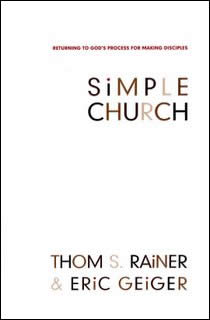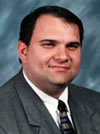Book Review (2 of 2)—Simple Church
Editor’s Note: Two men requested to review this particular book for SI. Because this book has been the topic of a fair amount of discussion in Christian circles since its appearance last June, I was glad to have two independent perspectives. This is the second of two reviews of Simple Church. —Jason Button, Book Review Editor
Simple Church: Returning to God’s Process for Making Disciples by Thom S. Rainer and Eric Geiger (Nashville: Broadman & Holman, 2006), 257 pp. $19.99/hardcover. Purchase: B&H, CBD, Amazon
Purchase: B&H, CBD, Amazon
Appendices:
- Research Design Methodology
- FAQs
ISBNs: 0805443908 / 978-0805443905
LCCN: BV652.25 R368 2006x
DCN: 254.5
Subject(s): Evangelicalism, Church Growth
Front Cover | Front Flap | Table of Contents | Excerpt | Back Flap | Back Cover
Thom S. Rainer is the President and CEO of Lifeway Christian Resources and a frequent speaker and church consultant. Dr. Rainer has authored or co-authored 16 previous books, including Breakout Churches, The Unchurched Next Door, and Eating the Elephant.
Eric Geiger is the executive pastor of Christ Fellowship (formerly First Baptist Church of Perrine), a large, multi-cultural church in the area of Miami, Florida.
Simple Church is one more in a myriad of books that deal with the issues of church growth and effective ministry in churches. In Simple Church, authors Rainer and Geiger attempt to show that the key to vibrant churches is to do away with the complexity of multiple programs adapted for various purposes and instead to redesign the church around a single, simplified process. While Rainer and Geiger seem to overstate some of their research to make their point, Simple Church has some materials and insights that can be a help to pastors and leaders who feel like they have become managers of programs rather than ministers to people.
“Out of complexity, find simplicity.” With this quote by Albert Einstein, Simple Church begins its push to encourage church leaders to simplify. In fact, on the first page, it promises, “This book will help you design a simple process of discipleship in your church. It will help you implement the model you have chosen. It will help you simplify.”
Clarity, Alignment, Movement, and Focus
Clarity—They define clarity as “the ability of the process to be communicated and understood by the people” (p. 111). They challenge church leaders to consider the fact that “if the process is not clearly defined so that everyone is speaking the same language, there is confusion and frustration.”
Movement—They define movement as “the sequential steps in the process that causes people to move to greater areas of commitment” (p. 139). They argue that “stagnant believers and congested churches go hand in hand” (p. 136).
Alignment—They define alignment as “the arrangement of all ministries and staff around the same simple process” (p. 168). They explain that “it is not enough to unite the church around the same what (purpose), but they also must be aligned on the same how (process)” (p. 168).
Focus—They define focus as “the commitment to abandon everything that falls outside of the simple ministry process” (p. 203). They exhort church leaders to focus on one thing. Also, they add that “while clarity, movement, and alignment are essential, they are meaningless without focus” (p. 203).
In the concluding chapter, the authors use Malachi 1 and examples from the medical field to urge church leaders to “Change or Die” (p. 229). They outline a four-step process (connected to the four key aspects of a simple church) for becoming a “simple church.” They conclude by declaring that “the simple church revolution has begun” and by asking, “Are you in?”
Rainer and Geiger succeed in producing a readable book that deals with an important topic. The need for various aspects of ministry to function together should be evident to most pastors, but it is easy to hold onto specific programs long after they fit their main purpose due to traditional or pragmatic reasons. This book does a good job of challenging that paradigm and encouraging the reader to consider the “how” aspects of what is going on in the church. Church leaders are exhorted to refocus and pursue a unified process in which discipleship and spiritual growth are intentional rather than accidental.
The concepts about hiring staff with the “process” in mind are also interesting. I would hope that churches and pastors would understand the need to bring on staff that are a fit in ministry philosophy, but based on some of the examples given, I wonder how often hiring is the result of a person’s talent or reputation instead of how he fits into the overall picture of what the church is trying to accomplish.
When it comes to areas of research, I have some concerns about statements regarding some of the conclusions of that research. For instance, several times the authors state that something is “vital” though even when the majority of “vibrant” churches have not indicated they “agree or strongly agree” (the standard the authors use throughout the book) with the statement the authors use to prove their point. While it would be accurate to indicate that there is a correlation in this area or that “vibrant churches” are more likely than “comparison churches” to do X or state X, to call something “vital” seems to raise it to a higher standard. For example, on page 148, the authors claim that “moving people through your ministry process is vital,” and they give the statement they used to test that statement—“we are intentional about moving people from one program to another.” The survey results to that question (on the next page) indicated that 37 percent of the vibrant churches “strongly agreed” or “agreed” with that statement compared to only 15 percent of the comparison churches. I wonder, “How can something be ‘vital’ if even the majority of the churches the authors are promoting as ‘vibrant and growing’ churches do not agree or strongly agree with the statement?”
When the reader looks at the survey results, he sees that there are some areas the survey does point out as being very important (such as having a class for new attenders), but in many areas the connections are not as strong as the authors try to indicate. The most blatant example of using statistics to make a point they do not make is found in regard to the statement “We limit the number of conferences and special events that we do as a church” on pages 216-217. Instead of following the pattern throughout the book of emphasizing the percentages that “agree” or “strongly agree” with this statement, the authors first point out that the “strongly agree” is 25 percent to 6 percent (vibrant versus comparison churches). If the reader looks at the actual data, he discovers that if he considers all three levels of “agree” with that statement, they are almost in a statistical dead heat (78 to 76 percent). (Due to the presentation of the data using bar graphs without corresponding numbers, it is difficult to be exact on any numbers except those specifically mentioned in the book.)
Also helpful would have been to have the questions and resulting answers compiled together in an appendix. While the survey results are given, they are spread throughout the four chapters on clarity, movement, alignment, and focus. Placing the survey results together would have made it easier to evaluate the survey and its results and to consider other implications of the survey.
The book also seems to downplay the importance of Bible preaching and right doctrine. I recognize that early in the book the authors touch on this topic by saying, “Thom has written several books on the primacy of sound, biblical, and orthodox doctrine in growing churches” (pp. 14-15). As one reads through the book, he discovers that the focus is process-oriented and could conceivably work regardless of what a church preaches or teaches.
I found another feature to be disconcerting. As demonstrated through the churches highlighted throughout the book, there seems to be a general assumption that the main service(s) of the church are to be viewed as the way to attract visitors rather than to prepare saints. I realize that even fundamental churches disagree as to the nature of the Sunday morning service; but in every case, the process moved from the main service as a gateway to small groups or to ministry/service groups without asking whether the worship service should be the gateway for visitors to begin the process of spiritual maturity.
Simple Church is targeted at evangelical churches and pastors who are overwhelmed with the busyness of church and are looking for a way out. For this audience, the message of the book offers hope—hope that everything will get better if they become a simple church. While the authors agree in the second appendix that “ultimately it is God who brings growth and vitality to a local church” and “it is against the laws of research to assert causation” (p. 249), the book promotes the idea that if readers follow the authors’ advice, their church can move from being a dying church to a vibrant and growing church.
If you are a fundamentalist pastor who has found himself more involved in managing programs than in ministering to people, the message in this book may be helpful to you. Consider the nature of the various programs in your church. Make sure they not only fit the purpose of your church but also contribute to the process of moving folks towards greater spiritual maturity.
I found the book to be readable, but the book’s message could have been said in half as many pages. The authors clearly believe in the case they are making and make a strong case against the ministry schizophrenia that comes from incorporating fad programs from the latest conference. I found the material on “movement” to be particularly challenging since I’ve had to think through how to encourage people to move from being attenders to becoming more mature in Christ and eventually serving. I was also encouraged to implement a more detailed approach to dealing with new members or prospective members.
If you struggle with being overwhelmed in ministry, this book provides helpful suggestions for refocusing the ministry of your church and is worth getting a copy. If you’re not quite at that stage, the book provides a read that may help you to clarify how your church does ministry or to think through that process in your church and how you articulate that process.
 Frank Sansone has served as pastor of Fellowship Baptist Church (Salisbury, MD) since December 2004. He also served as youth pastor and assistant pastor for 13 years in churches in North and South Carolina and New Jersey. He has traveled with an evangelistic team and preached in a number of churches, camps, and Christian schools. Frank enjoys spending his free time with his wife, Missy, and his three children; coaching his children in soccer; and writing on his blog. Frank Sansone has served as pastor of Fellowship Baptist Church (Salisbury, MD) since December 2004. He also served as youth pastor and assistant pastor for 13 years in churches in North and South Carolina and New Jersey. He has traveled with an evangelistic team and preached in a number of churches, camps, and Christian schools. Frank enjoys spending his free time with his wife, Missy, and his three children; coaching his children in soccer; and writing on his blog. |
- 10 views


Discussion